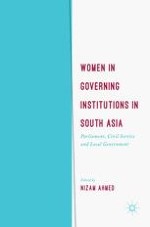2018 | OriginalPaper | Buchkapitel
6. Who Speaks for Women in Parliament? Patriarchy and Women MNAs in Pakistan
verfasst von : Nusrat Jahan Chowdhury
Erschienen in: Women in Governing Institutions in South Asia
Aktivieren Sie unsere intelligente Suche, um passende Fachinhalte oder Patente zu finden.
Wählen Sie Textabschnitte aus um mit Künstlicher Intelligenz passenden Patente zu finden. powered by
Markieren Sie Textabschnitte, um KI-gestützt weitere passende Inhalte zu finden. powered by
